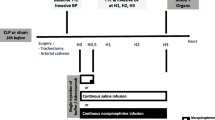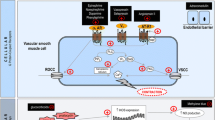Abstract
Objective
Current therapies of sepsis and septic shock require administration of a large volume of fluid to maintain hemodynamic stability. The vasoregulatory peptide adrenomedullin has been shown to prevent the transition to the fatal hypocirculatory septic state by poorly understood mechanisms. We tested the hypothesis that therapeutic administration of adrenomedullin would reduce vascular hyperpermeability, thereby contributing to improved hemodynamics and survival.
Design
Prospective randomized controlled animal study.
Subjects
Male Sprague–Dawley rats (270 g).
Interventions
We used 4.8 × 103 U/kg of Staphylococcus aureus α-toxin, a pore-forming exotoxin, to induce vascular leakage and circulatory shock in rats. The infusion rate was 24 μg/kg per hour. Adrenomedullin was started 1 h after α-toxin administration.
Measurement and results
Infusion of α-toxin in rats induced cardiocirculatory failure resulting in a 6-h mortality of 53%. α-Toxin provoked massive vascular hyperpermeability, which was indicated by an enrichment of Evans blue dye albumin in the tissues of lung, liver, ileum and kidney. Plasma fluid loss led to a significant hemoconcentration. Hemodynamic impairment observed after α-toxin infusion was closely correlated to vascular hyperpermeability. Therapeutic administration of 24 μg/kg per hour adrenomedullin reduced 6-h mortality from 53% to 7%. Stabilization of the endothelial barrier by adrenomedullin was indicated by reduced extravasation of albumin and plasma fluid and may have contributed to hemodynamic improvement.
Conclusions
These data suggest that adrenomedullin-related reduction of vascular hyperpermeability might represent a novel and important mechanism contributing to the beneficial effects of this endogenous vasoregulatory peptide in sepsis and septic shock.





Similar content being viewed by others
References
Martin GS, Mannino DM, Eaton S, Moss M (2003) The epidemiology of sepsis in the United States from 1979 through 2000. N Engl J Med 348:1546–1554
Hinshaw LB (1996) Sepsis/septic shock: participation of the microcirculation: an abbreviated review. Crit Care Med 24:1072–1078
Volk T, Kox WJ (2000) Endothelium function in sepsis. Inflamm Res 49:185–198
Aird WC (2003) The role of the endothelium in severe sepsis and multiple organ dysfunction syndrome. Blood 101:3765–3777
Orfanos SE, Mavrommati I, Korovesi I, Roussos C (2004) Pulmonary endothelium in acute lung injury: from basic science to the critically ill. Intensive Care Med 30:1702–1714
Ueda S, Nishio K, Minamino N, Kubo A, Akai Y, Kangawa K, Matsuo H, Fujimura Y, Yoshioka A, Masui K, Doi N, Murao Y, Miyamoto S (1999) Increased plasma levels of adrenomedullin in patients with systemic inflammatory response syndrome. Am J Respir Crit Care Med 160:132–136
Shindo T, Kurihara H, Maemura K, Kurihara Y, Kuwaki T, Izumida T, Minamino N, Ju KH, Morita H, Oh-hashi Y, Kumada M, Kangawa K, Nagai R, Yazaki Y (2000) Hypotension and resistance to lipopolysaccharide-induced shock in transgenic mice overexpressing adrenomedullin in their vasculature. Circulation 101:2309–2316
Yang S, Zhou M, Fowler DE, Wang P (2002) Mechanisms of the beneficial effect of adrenomedullin and adrenomedullin-binding protein-1 in sepsis: down-regulation of proinflammatory cytokines. Crit Care Med 30:2729–2735
Yang S, Zhou M, Chaudry IH, Wang P (2002) Novel approach to prevent the transition from the hyperdynamic phase to the hypodynamic phase of sepsis: role of adrenomedullin and adrenomedullin binding protein-1. Ann Surg 236:625–633
Cui X, Wu R, Zhou M, Dong W, Ulloa L, Yang H, Wang H, Tracey KJ, Simms HH, Wang P (2005) Adrenomedullin and its binding protein attenuate the proinflammatory response after hemorrhage. Crit Care Med 33:391–398
Sata M, Kakoki M, Nagata D, Nishimatsu H, Suzuki E, Aoyagi T, Sugiura S, Kojima H, Nagano T, Kangawa K, Matsuo H, Omata M, Nagai R, Hirata Y (2000) Adrenomedullin and nitric oxide inhibit human endothelial cell apoptosis via a cyclic GMP-independent mechanism. Hypertension 36:83–88
Westphal M, Stubbe H, Bone HG, Daudel F, Vocke S, Van Aken H, Booke M (2002) Hemodynamic effects of exogenous adrenomedullin in healthy and endotoxemic sheep. Biochem Biophys Res Commun 296:134–138
De Matteo R, May CN (2003) Direct coronary vasodilator action of adrenomedullin is mediated by nitric oxide. Br J Pharmacol 140:1414–1420
Stangl V, Dschietzig T, Bramlage P, Boye P, Kinkel HT, Staudt A, Baumann G, Felix SB, Stangl K (2000) Adrenomedullin and myocardial contractility in the rat. Eur J Pharmacol 408:83–89
Parkes DG, May CN (1997) Direct cardiac and vascular actions of adrenomedullin in conscious sheep. Br J Pharmacol 120:1179–1185
Charles CJ, Jardine DL, Nicholls MG, Richards AM (2005) Adrenomedullin increases cardiac sympathetic nerve activity in normal conscious sheep. J Endocrinol 187:275–281
Hippenstiel S, Witzenrath M, Schmeck B, Hocke A, Krisp M, Krull M, Seybold J, Seeger W, Rascher W, Schutte H, Suttorp N (2002) Adrenomedullin reduces endothelial hyperpermeability. Circ Res 91:618–625
Brell B, Temmesfeld-Wollbruck B, Altzschner I, Frisch E, Schmeck B, Hocke AC, Suttorp N, Hippenstiel S (2005) Adrenomedullin reduces Staphylococcus aureus alpha-toxin-induced rat ileum microcirculatory damage. Crit Care Med 33:819–826
Lowy FD (1998) Staphylococcus aureus infections. N Engl J Med 339:520–532
Seeger W, Birkemeyer RG, Ermert L, Suttorp N, Bhakdi S, Duncker HR (1990) Staphylococcal alpha-toxin-induced vascular leakage in isolated perfused rabbit lungs. Lab Invest 63:341–349
Grimminger F, Rose F, Sibelius U, Meinhardt M, Potzsch B, Spriestersbach R, Bhakdi S, Suttorp N, Seeger W (1997) Human endothelial cell activation and mediator release in response to the bacterial exotoxins Escherichia coli hemolysin and staphylococcal alpha-toxin. J Immunol 159:1909–1916
Brell B, Hippenstiel S, David I, Pries AR, Habazettl H, Schmeck B, Suttorp N, Temmesfeld-Wollbruck B (2005) Adrenomedullin treatment abolishes ileal mucosal hypoperfusion induced by Staphylococcus aureus alpha-toxin–an intravital microscopic study on an isolated rat ileum. Crit Care Med 33:2810–2816
Sibelius U, Grandel U, Buerke M, Mueller D, Kiss L, Kraemer HJ, Braun-Dullaeus R, Haberbosch W, Seeger W, Grimminger F (2000) Staphylococcal alpha-toxin provokes coronary vasoconstriction and loss in myocardial contractility in perfused rat hearts: role of thromboxane generation. Circulation 101:78–85
Temmesfeld-Wollbruck B, Szalay A, Mayer K, Olschewski H, Seeger W, Grimminger F (1998) Abnormalities of gastric mucosal oxygenation in septic shock: partial responsiveness to dopexamine. Am J Respir Crit Care Med 157:1586–1592
Cabrales P, Acero C, Intaglietta M, Tsai AG (2003) Measurement of the cardiac output in small animals by thermodilution. Microvasc Res 66:77–82
Patterson CE, Rhoades RA, Garcia JG (1992) Evans blue dye as a marker of albumin clearance in cultured endothelial monolayer and isolated lung. J Appl Physiol 72:865–873
Falk S, Goggel R, Heydasch U, Brasch F, Muller KM, Wendel A, Uhlig S (1999) Quinolines attenuate PAF-induced pulmonary pressor responses and edema formation. Am J Respir Crit Care Med 160:1734–1742
Forgacs B, Eibl G, Faulhaber J, Kahrau S, Buhr H, Foitzik T (2000) Effect of fluid resuscitation with and without endothelin A receptor blockade on hemoconcentration and organ function in experimental pancreatitis. Eur Surg Res 32:162–168
Wisplinghoff H, Bischoff T, Tallent SM, Seifert H, Wenzel RP, Edmond MB (2004) Nosocomial bloodstream infections in US hospitals: analysis of 24,179 cases from a prospective nationwide surveillance study. Clin Infect Dis 39:309–317
Richards MJ, Edwards JR, Culver DH, Gaynes RP (1999) Nosocomial infections in medical intensive care units in the United States. National Nosocomial Infections Surveillance System. Crit Care Med 27:887–892
Soderquist B, Colgue-Navarro P, Blomquist L, Olcén P, Holmberg H, Möllby R (1993) Staphylococcal alpha-toxin in septicaemic patients; detection in serum, antibody response and production in isolated strain. Serodiagn Immunother Infect Dis 5:139–144
Li S, Arvidson S, Mollby R (1997) Variation in the agr-dependent expression of alpha-toxin and protein A among clinical isolates of Staphylococcus aureus from patients with septicaemia. FEMS Microbiol Lett 152:155–161
Kernodle DS, Voladri RK, Menzies BE, Hager CC, Edwards KM (1997) Expression of an antisense hla fragment in Staphylococcus aureus reduces alpha-toxin production in vitro and attenuates lethal activity in a murine model. Infect Immun 65:179–184
Patel AH, Nowlan P, Weavers ED, Foster T (1987) Virulence of protein A-deficient and alpha-toxin-deficient mutants of Staphylococcus aureus isolated by allele replacement. Infect Immun 55:3103–3110
Blomqvist L, Appelgren LE, Thelestam M (1987) Distribution of 3H-labeled staphylococcal alpha-toxin and a toxin fragment in mice. Infect Immun 55:1906–1913
Lortie M, Gauthier B, Plante GE (1994) Renal reperfusion injury: sequential changes in function and regional albumin extravasation. Microvasc Res 48:295–302
Suttorp N, Hessz T, Seeger W, Wilke A, Koob R, Lutz F, Drenckhahn D (1988) Bacterial exotoxins and endothelial permeability for water and albumin in vitro. Am J Physiol 255:C368–C376
Bhakdi S, Tranum-Jensen J (1991) Alpha-toxin of Staphylococcus aureus. Microbiol Rev 55:733–751
Ueda S, Nishio K, Minamino N, Kubo A, Akai Y, Kangawa K, Matsuo H, Fujimura Y, Yoshioka A, Masui K, Doi N, Murao Y, Miyamoto S (1999) Increased plasma levels of adrenomedullin in patients with systemic inflammatory response syndrome. Am J Respir Crit Care Med 160:132–136
Ross GR, Yallampalli C (2007) Vascular hyper-responsiveness to adrenomedullin during pregnancy is associated with increased generation of cyclic nucleotides in rat mesenteric artery. Biol Reprod 76:118–123
Okamura T, Ayajiki K, Kangawa K, Toda N (1997) Mechanism of adrenomedullin-induced relaxation in isolated canine retinal arteries. Invest Ophthalmol Vis Sci 38:56–61
Caron KM, Smithies O (2001) Extreme hydrops fetalis and cardiovascular abnormalities in mice lacking a functional Adrenomedullin gene. Proc Natl Acad Sci USA 98:615–619
Rivers E, Nguyen B, Havstad S, Ressler J, Muzzin A, Knoblich B, Peterson E, Tomlanovich M (2001) Early goal-directed therapy in the treatment of severe sepsis and septic shock. N Engl J Med 345:1368–1377
Acknowledgements
The authors thank Prof. Dr. med. Sucharit Bhakdi from Johannes Gutenberg University, Mainz, Germany who generously provided purified S. aureus α-toxin. This work was supported by grants from the Deutsche Forschungsgemeinschaft to N.S. (SSP 1130) and S.H. (HI 789/5–1), the Bundesministerium für Bildung und Forschung to S.H. (BMBF-Competence Network CAPNETZ C15), and the Charité to B.T.-W. (Rahel Hirsch award).
Author information
Authors and Affiliations
Corresponding author
Additional information
Bettina Temmesfeld-Wollbrück and Bernhard Brell contributed equally to this study
Electronic supplementary material
Rights and permissions
About this article
Cite this article
Temmesfeld-Wollbrück, B., Brell, B., Dávid, I. et al. Adrenomedullin reduces vascular hyperpermeability and improves survival in rat septic shock. Intensive Care Med 33, 703–710 (2007). https://doi.org/10.1007/s00134-007-0561-y
Received:
Accepted:
Published:
Issue Date:
DOI: https://doi.org/10.1007/s00134-007-0561-y




